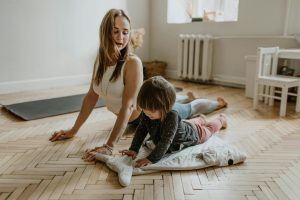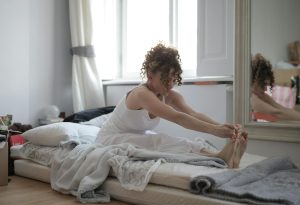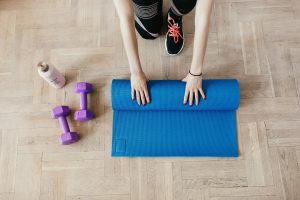Introduction
In today’s fast-paced world, finding time to visit a gym can be challenging. Moreover, the ongoing pandemic has made it essential to exercise at home without any equipment. This article provides a detailed guide to home workouts for beginners that do not require any gym equipment. These workouts are designed to help you build strength, endurance, and flexibility while ensuring a full-body workout.
- Warm-up
Before starting any exercise routine, it is crucial to warm up your body to prevent injuries and improve performance. A five to ten-minute warm-up can include:
- Light jogging in place
- Arm circles
- High knees
- Butt kicks
- Jumping jacks
- Bodyweight Squats
Squats are an excellent exercise to strengthen your lower body, particularly your quadriceps, hamstrings, and glutes. To perform a bodyweight squat:
- Stand with your feet shoulder-width apart.
- Lower your hips as if sitting on an invisible chair, keeping your back straight.
- Push through your heels to return to the starting position.
- Push-ups
Push-ups are a classic exercise that targets your chest, shoulders, and triceps. If regular push-ups are too challenging, you can start with wall push-ups or perform push-ups on your knees.
- Place your hands on the floor, slightly wider than shoulder-width apart.
- Extend your legs behind you, keeping your body straight.
- Lower your chest towards the floor and then push back up to the starting position.
- Planks
Planks are an effective core exercise that also engages your glutes and lower back. To perform a plank:
- Begin in a push-up position.
- Lower yourself onto your forearms, ensuring your elbows are directly beneath your shoulders.
- Keep your body straight and hold the position for as long as possible.
- Lunges
Lunges are an excellent exercise to target your legs, particularly your quadriceps, hamstrings, and glutes. To perform a lunge:
- Stand with your feet hip-width apart.
- Take a large step forward with one leg, lowering your hips until both knees form 90-degree angles.
- Push through your front heel to return to the starting position and repeat with the opposite leg.
- Jumping Jacks
Jumping jacks are a simple yet effective cardiovascular exercise that engages your entire body. To perform a jumping jack:
- Stand with your feet together and your arms at your sides.
- Jump your feet apart while raising your arms overhead, then jump back to the starting position.
- Sit-ups
Sit-ups target your abdominal muscles and help improve core strength. To perform a sit-up:
- Lie flat on your back with your knees bent and your feet flat on the floor.
- Place your hands behind your head, keeping your elbows wide.
- Engage your core and lift your torso towards your knees, then lower back down to the starting position.
- Cool-down and Stretching
After completing your workout, it is essential to cool down and stretch your muscles to prevent soreness and improve flexibility. A five to ten-minute cool-down can include:
- Walking in place
- Gentle stretches for each muscle group

Tailored Home Workouts for Beginners Across Different Age Groups
Home workouts offer a flexible and accessible way for individuals of all ages to maintain their fitness levels and overall well-being. This article provides detailed home workout recommendations for beginners across different age groups, ensuring that each routine caters to the specific needs and abilities of each group.
Children (Age 6-12)
Workouts for children should focus on building fundamental motor skills, coordination, and overall fitness. A sample workout for this age group could include:
- Warm-up (5 minutes): Jumping jacks, high knees, and light jogging in place
- Squats (2 sets of 10 repetitions)
- Lunges (2 sets of 10 repetitions)
- Push-ups (2 sets of 8-10 repetitions, or wall push-ups for beginners)
- Plank (2 sets of 15-30 seconds)
- Jumping jacks (2 sets of 30 seconds)
- Cool-down and stretching (5 minutes): Gentle stretches for major muscle groups
Teenagers (Age 13-18)
As teenagers grow and develop, their workouts should focus on building strength, endurance, and flexibility. A sample workout for this age group could include:
- Warm-up (5 minutes): Dynamic stretches like leg swings, arm circles, and light jogging in place
- Bodyweight squats (3 sets of 12 repetitions)
- Push-ups (3 sets of 12 repetitions)
- Lunges (3 sets of 12 repetitions)
- Incline push-ups or bench dips (2 sets of 10 repetitions)
- Plank (3 sets of 30 seconds)
- Jumping jacks (3 sets of 30 seconds)
- Cool-down and stretching (5 minutes): Static stretches for major muscle groups
Young Adults (Age 18-30)
Young adults should focus on building and maintaining overall strength, endurance, and flexibility. A sample workout for this age group could include:
- Warm-up (5 minutes): Dynamic stretches and light cardio exercises like high knees, butt kicks, and jumping jacks
- Bodyweight squats (4 sets of 15 repetitions)
- Push-ups (4 sets of 15 repetitions)
- Lunges (4 sets of 15 repetitions)
- Step-ups (3 sets of 12 repetitions, using a sturdy chair or bench)
- Plank (4 sets of 45 seconds)
- Mountain climbers (3 sets of 30 seconds)
- Cool-down and stretching (5 minutes): Static stretches for major muscle groups
Adults (Age 30-50)
As adults age, it’s crucial to maintain strength, flexibility, and cardiovascular health. A sample workout for this age group could include:
- Warm-up (5 minutes): Dynamic stretches, light jogging in place, and arm circles
- Bodyweight squats (4 sets of 12 repetitions)
- Push-ups (4 sets of 10 repetitions)
- Lunges (4 sets of 10 repetitions)
- Tricep dips (3 sets of 10 repetitions, using a sturdy chair or bench)
- Plank (4 sets of 60 seconds)
- Jumping jacks (3 sets of 30 seconds)
- Cool-down and stretching (5 minutes): Gentle stretches for major muscle groups
Mature Adults (Age 50+)
For mature adults, focus on maintaining balance, flexibility, and overall strength. A sample workout for this age group could include:
- Warm-up (5 minutes): Light cardio exercises like marching in place and gentle arm swings
- Seated leg lifts (3 sets of 15 repetitions)
- Seated bicep curls (3 sets of 15 repetitions)
- Seated shoulder press (3 sets of 15 repetitions)
- Chair squats (3 sets of 10 repetitions)
- Seated back rows with resistance bands (3 sets of 10 repetitions)
- Seated hip abduction and adduction (3 sets of 15 repetitions)
- Cool-down and stretching (5 minutes): Gentle stretches for major muscle groups
Tailoring home workouts to different age groups ensures that individuals can safely and effectively improve their fitness levels. By following these age-specific workout recommendations, individuals can maintain their overall health and well-being without the need for a gym membership or specialized equipment.

Precautions for Home Workouts Without Equipment
Home workouts without equipment offer a convenient and accessible way to maintain fitness and overall well-being. However, to ensure safety and effectiveness, it is crucial to follow specific precautions. This article provides a comprehensive guide to the precautions you should take while performing home workouts without equipment.
Warm-up and Cool-down
Always begin your workout with a proper warm-up to prepare your body for the exercises and prevent injuries. A warm-up should last for about 5 to 10 minutes and include light cardio activities like jogging in place, arm circles, high knees, and jumping jacks. Similarly, cool down and stretch your muscles after completing your workout to prevent soreness and improve flexibility.
Proper Form and Technique
Maintaining proper form and technique during your workouts is essential to avoid injuries and ensure the exercises target the correct muscle groups. Research and learn the correct way to perform each exercise, and if needed, consult a fitness professional or watch instructional videos.
Gradual Progression
Start with beginner-level exercises and gradually increase the intensity, duration, and complexity of your workouts. This approach allows your body to adapt to the new demands and reduces the risk of injuries.
Listen to Your Body
Pay attention to your body’s signals and stop exercising if you experience pain, discomfort, or fatigue. Pushing through the pain can lead to injuries and hinder your progress. If you feel pain during or after a workout, consider modifying the exercise or taking a break until the discomfort subsides.
Hydration and Nutrition
Staying hydrated is crucial during workouts to maintain optimal performance and prevent dehydration. Drink water before, during, and after your exercise sessions. Additionally, maintain a balanced diet to provide your body with the necessary nutrients for energy, muscle recovery, and overall health.
Workout Surface and Environment
Choose a suitable workout area with a flat, non-slippery surface to minimize the risk of falls and injuries. Ensure there is enough space to perform each exercise without obstructions. Also, maintain proper lighting and ventilation to create a comfortable environment for your workouts.
Wear Appropriate Clothing and Footwear
Wear comfortable, breathable clothing that allows for a full range of motion during your workouts. If you plan to perform exercises that require jumping or high-impact movements, consider wearing appropriate footwear to provide support and cushioning.
Safety Equipment
While home workouts don’t require gym equipment, some safety equipment can be beneficial. For example, using a yoga mat for floor exercises can provide cushioning and grip, preventing slips and injuries. Additionally, a resistance band can enhance the effectiveness of bodyweight exercises by adding resistance.
Warm-up and Transition Exercises
When transitioning between exercises, perform a few warm-up movements or gentle stretches to prepare your muscles for the new activity. This approach can help prevent injuries and ensure a smooth workout flow.
Consistency and Patience
Consistency is key to achieving fitness goals. Establish a workout schedule and stick to it, even on days when you may not feel motivated. Remember that progress takes time, and it’s essential to be patient with your fitness journey.
Following these precautions while performing home workouts without equipment ensures a safe and effective fitness routine. By prioritizing your well-being and taking necessary measures, you can achieve your fitness goals and maintain a healthy lifestyle.

The Role of Diet in Supporting Fitness Goals
A balanced diet is essential for providing the necessary nutrients, energy, and support for a beginner’s fitness journey. Some key aspects to consider include:
- Macronutrients: Aim for a balanced intake of carbohydrates, proteins, and fats. Carbohydrates provide energy for workouts, proteins help build and repair muscles, and fats support overall health.
- Micronutrients: Include a variety of fruits, vegetables, whole grains, and lean proteins to ensure adequate intake of vitamins and minerals. These nutrients support immune function, energy production, and overall health.
- Hydration: Drink plenty of water throughout the day to maintain optimal hydration, which is crucial for performance during workouts and recovery afterward.
- Portion Control and Calorie Management: Monitor portion sizes and calorie intake to support weight management goals. Consult a registered dietitian or nutritionist for personalized advice.
- Timing: Consume a balanced meal or snack with carbohydrates and protein within 30-60 minutes after a workout to support muscle recovery and growth.
A beginner-friendly home workout without equipment, combined with a balanced diet, can significantly contribute to achieving fitness goals and promoting overall well-being. By focusing on strength, flexibility, and cardiovascular exercises, along with proper nutrition, beginners can establish a solid foundation for their fitness journey.
Advantages of Home Workouts for Beginners
Home workouts without equipment offer numerous advantages for beginners looking to start their fitness journey. These workouts provide a convenient, accessible, and cost-effective way to improve overall health and well-being. This article highlights the benefits of home workouts for beginners without equipment.
Convenience and Accessibility
Home workouts eliminate the need to travel to a gym or fitness center, saving time and effort. You can exercise in the comfort of your own home, at any time that suits your schedule. This flexibility allows you to maintain a consistent workout routine without being hindered by external factors such as weather or facility hours.
Cost-Effective
Gym memberships and equipment purchases can be expensive, especially for beginners who may not yet know their preferences or long-term commitment to fitness. Home workouts require no equipment, making them a budget-friendly option that still provides effective results.
No Learning Curve
When starting at a gym, beginners may feel overwhelmed by the various machines and equipment. Home workouts, on the other hand, typically involve bodyweight exercises that are easy to learn and perform. This simplicity allows beginners to focus on mastering proper form and technique without the added stress of navigating unfamiliar equipment.
Customizable Workouts
Home workouts offer the flexibility to tailor your routine to your individual needs, preferences, and fitness goals. As you progress, you can easily modify exercises to increase intensity, duration, or complexity. This personalization ensures that your workouts remain challenging and engaging, preventing boredom and promoting long-term adherence to your fitness journey.
Comfort and Privacy
Working out at home provides a comfortable and private environment, allowing you to exercise in your own space without feeling self-conscious or judged. This setting can help alleviate performance anxiety and encourage a more enjoyable workout experience.
Encourages Consistency
Home workouts eliminate barriers such as transportation, scheduling conflicts, and social anxiety that may prevent you from attending a gym regularly. By removing these obstacles, you are more likely to maintain a consistent workout routine, leading to better overall results and improved fitness levels.
Whole-Body Workouts
Bodyweight exercises used in home workouts engage multiple muscle groups simultaneously, providing a well-rounded workout that targets various areas of the body. This approach helps improve strength, flexibility, and cardiovascular health, contributing to overall well-being.
Promotes Healthy Habits
Starting a home workout routine as a beginner without equipment encourages the development of healthy habits. By establishing a consistent exercise routine, you are more likely to adopt other positive habits such as eating a balanced diet, getting adequate sleep, and practicing stress management techniques.
Conclusion
These home workouts for beginners, requiring no equipment, are an excellent way to stay fit and healthy without stepping foot in a gym. By incorporating these exercises into your routine, you can improve your overall strength, endurance, and flexibility. Remember to listen to your body, maintain proper form, and gradually increase the intensity and duration of your workouts as you progress.
